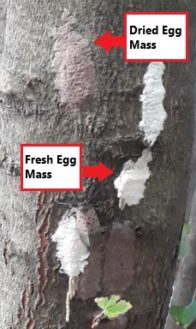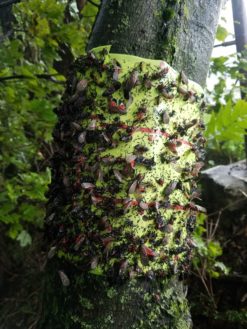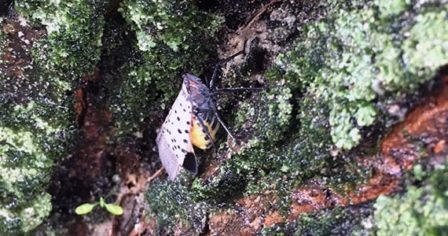Lots of homeowners and property managers in Central PA are concerned about the Spotted Lanternfly lately. There are several ways you can help control the spread of this invasive pest. Here are four tips to get rid of Spotted Lanternfly.
How To Get Rid of Spotted Lanternfly
1. Remove Ailanthus trees
Spotted Lanternfly requires the ailanthus altissima to reproduce. This tree is the spotted lanternfly’s primary target. Because of this, the first step you should take to get rid of this pest is removing these trees from your property. This is a must for managing this pest!
Control for ailanthus trees is never simple – they’re very hardy plants! What is generally recognized as the most effective control method is called “hack and squirt,” and involves cutting notches in the bark around the circumference of the tree. Herbicide should be applied directly into the wound, once these notches have been cut into the tree.
A selective herbicide containing the chemical triclopyr may be used without damage to plants around the ailanthus tree. However, if you are not a registered pesticide applicator in Pennsylvania and want to DIY this, a product with glyphosate (like Roundup) will work. Use caution, however – not only are you applying an herbicide, but glyphosate is non-selective, meaning it kills any plant it touches. If you don’t want to damage other plants around the tree, you may want to contact your local pest control company to help.
2. Removing Spotted Lanternfly egg masses
During Fall and Winter months, and after a hard freeze, it’s a great idea to inspect your property. Look closely at the siding on your home, your cars, your grill, the trailer or RV, mailbox, trees and shrubs on the property, old piles of debris – give it a thorough inspection!
You should also inspect your cars any time you’re leaving the quarantine zone for egg masses. If you’re going to be traveling to York, Dauphin, Cumberland, or Perry Counties, you should be inspecting your vehicle before you travel to ensure you’re not transporting SLF outside the quarantine zone.
If you see the egg masses from Spotted Lanternfly, scrape them into a bottle or sandwich bag containing rubbing alcohol or hand sanitizer. This will kill the eggs so they do not hatch. If using a sandwich bag, we recommend that you “double bag,” just to be safe. Scraped egg masses should be thrown away immediately.

3. Add sticky bands to catch nymphs
When nymphs first hatch in late Spring or early Summer, they tend to migrate to the fresher, greener parts of the tree where the new growth is to begin feeding. And this makes sense; it could their piercing/sucking mouthparts may not be as developed yet, and unable to penetrate more mature bark. Whatever the reason, it gives people trying to control their spread another tool in the arsenal – “sticky bands.”
The basic idea is simple: wrap the trunk of the tree in a sticky material that the nymphs will get stuck on. If they can’t get free and feed, they’ll certainly never reach adulthood! The Spotted Lanternfly Management for Homeowners published by Penn State even recommends simply using duct tape, and wrapping in backwards, tightly around the tree as an effective method for controlling nymphs.
Homeowners who are concerned about slowing the spread of this pest should target the trees we’ve mentioned first. Then, move on to other trees on their property with this same method. Sticky bands should be re-applied weekly during nymph stages (late May to September) for best results.
Note: “Sticky band” picture supplied by Heather Leach at Penn State University, and used with permission.
4. Use chemical control
This should be considered a final “backstop” to the other control methods we’ve outlined so far in this post. There isn’t a ton of information about what’s really effective on this pest right now. While experts agree that their nervous system is disrupted by available pesticides, none are presently labelled for use on the Spotted Lanternfly.
What seems to be working for now is a combination of two different pesticide approaches. These are commonly referred to as systemic and contact pesticides. Systemic pesticides are products that the plant material absorbs, and it stays inside the plant itself. This is how products like grub control work for your lawn. The product is absorbed into the plant. Then when an insect feeds on the plant, they ingest that product.
By contrast, contact pesticides are just what they sound like – they work on contact with the bug. Examples of contact products most homeowners are familiar with are Raid and Black Flag for things like spiders and ants. And, like those over-the-counter products, many contact pesticides also include a residual effect. This means that they’ll continue to kill bugs for a period of time (depending on the product used, rate of application, rainfall, etc.) after the application is completed.
Systemic products seem to be having really good results with the nymph stage of the Spotted Lanternfly right now. The adults are better controlled by contact products with regular follow up applications because they’re far more mobile.
If you have questions about protecting your trees from this pest, please Contact Us. We’d be happy to discuss your concerns.

